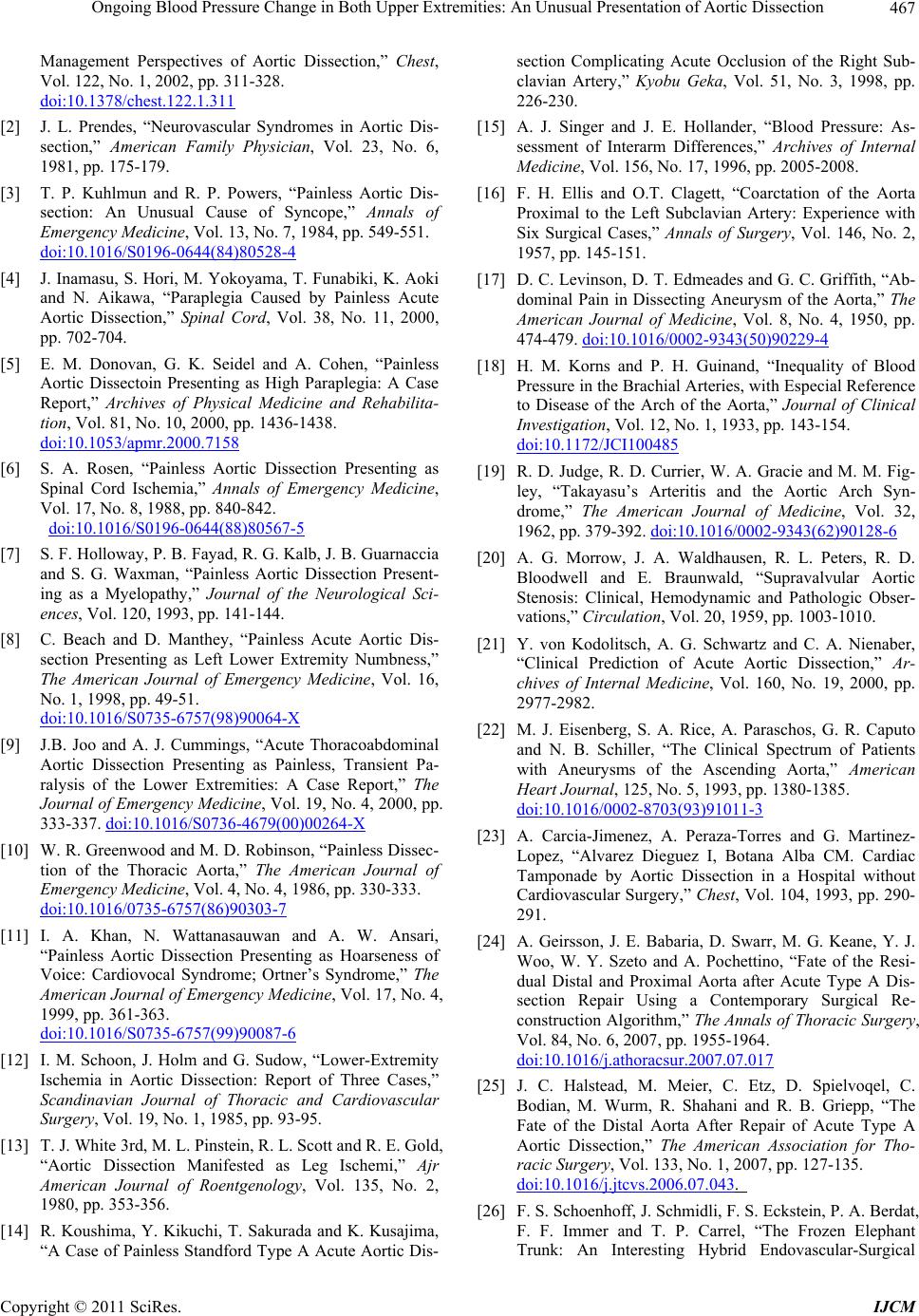
Ongoing Blood Pressure Change in Both Upper Extremities: An Unusual Presentation of Aortic Dissection467
Management Perspectives of Aortic Dissection,” Chest,
Vol. 122, No. 1, 2002, pp. 311-328.
doi:10.1378/chest.122.1.311
[2] J. L. Prendes, “Neurovascular Syndromes in Aortic Dis-
section,” American Family Physician, Vol. 23, No. 6,
1981, pp. 175-179.
[3] T. P. Kuhlmun and R. P. Powers, “Painless Aortic Dis-
section: An Unusual Cause of Syncope,” Annals of
Emergency Medicine, Vol. 13, No. 7, 1984, pp. 549-551.
doi:10.1016/S0196-0644(84)80528-4
[4] J. Inamasu, S. Hori, M. Yokoyama, T. Funabiki, K. Aoki
and N. Aikawa, “Paraplegia Caused by Painless Acute
Aortic Dissection,” Spinal Cord, Vol. 38, No. 11, 2000,
pp. 702-704.
[5] E. M. Donovan, G. K. Seidel and A. Cohen, “Painless
Aortic Dissectoin Presenting as High Paraplegia: A Case
Report,” Archives of Physical Medicine and Rehabilita-
tion, Vol. 81, No. 10, 2000, pp. 1436-1438.
doi:10.1053/apmr.2000.7158
[6] S. A. Rosen, “Painless Aortic Dissection Presenting as
Spinal Cord Ischemia,” Annals of Emergency Medicine,
Vol. 17, No. 8, 1988, pp. 840-842.
doi:10.1016/S0196-0644(88)80567-5
[7] S. F. Holloway, P. B. Fayad, R. G. Kalb, J. B. Guarnaccia
and S. G. Waxman, “Painless Aortic Dissection Present-
ing as a Myelopathy,” Journal of the Neurological Sci-
ences, Vol. 120, 1993, pp. 141-144.
[8] C. Beach and D. Manthey, “Painless Acute Aortic Dis-
section Presenting as Left Lower Extremity Numbness,”
The American Journal of Emergency Medicine, Vol. 16,
No. 1, 1998, pp. 49-51.
doi:10.1016/S0735-6757(98)90064-X
[9] J.B. Joo and A. J. Cummings, “Acute Thoracoabdominal
Aortic Dissection Presenting as Painless, Transient Pa-
ralysis of the Lower Extremities: A Case Report,” The
Journal of Emergency Medicine, Vol. 19, No. 4, 2000, pp.
333-337. doi:10.1016/S0736-4679(00)00264-X
[10] W. R. Greenwood and M. D. Robinson, “Painless Dissec-
tion of the Thoracic Aorta,” The American Journal of
Emergency Medicine, Vol. 4, No. 4, 1986, pp. 330-333.
doi:10.1016/0735-6757(86)90303-7
[11] I. A. Khan, N. Wattanasauwan and A. W. Ansari,
“Painless Aortic Dissection Presenting as Hoarseness of
Voice: Cardiovocal Syndrome; Ortner’s Syndrome,” The
American Journal of Emergency Medicine, Vol. 17, No. 4,
1999, pp. 361-363.
doi:10.1016/S0735-6757(99)90087-6
[12] I. M. Schoon, J. Holm and G. Sudow, “Lower-Extremity
Ischemia in Aortic Dissection: Report of Three Cases,”
Scandinavian Journal of Thoracic and Cardiovascular
Surgery, Vol. 19, No. 1, 1985, pp. 93-95.
[13] T. J. White 3rd, M. L. Pinstein, R. L. Scott and R. E. Gold,
“Aortic Dissection Manifested as Leg Ischemi,” Ajr
American Journal of Roentgenology, Vol. 135, No. 2,
1980, pp. 353-356.
[14] R. Koushima, Y. Kikuchi, T. Sakurada and K. Kusajima,
“A Case of Painless Standford Type A Acute Aortic Dis-
section Complicating Acute Occlusion of the Right Sub-
clavian Artery,” Kyobu Geka, Vol. 51, No. 3, 1998, pp.
226-230.
[15] A. J. Singer and J. E. Hollander, “Blood Pressure: As-
sessment of Interarm Differences,” Archives of Internal
Medicine, Vol. 156, No. 17, 1996, pp. 2005-2008.
[16] F. H. Ellis and O.T. Clagett, “Coarctation of the Aorta
Proximal to the Left Subclavian Artery: Experience with
Six Surgical Cases,” Annals of Surgery, Vol. 146, No. 2,
1957, pp. 145-151.
[17] D. C. Levinson, D. T. Edmeades and G. C. Griffith, “Ab-
dominal Pain in Dissecting Aneurysm of the Aorta,” The
American Journal of Medicine, Vol. 8, No. 4, 1950, pp.
474-479. doi:10.1016/0002-9343(50)90229-4
[18] H. M. Korns and P. H. Guinand, “Inequality of Blood
Pressure in the Brachial Arteries, with Especial Reference
to Disease of the Arch of the Aorta,” Journal of Clinical
Investigation, Vol. 12, No. 1, 1933, pp. 143-154.
doi:10.1172/JCI100485
[19] R. D. Judge, R. D. Currier, W. A. Gracie and M. M. Fig-
ley, “Takayasu’s Arteritis and the Aortic Arch Syn-
drome,” The American Journal of Medicine, Vol. 32,
1962, pp. 379-392. doi:10.1016/0002-9343(62)90128-6
[20] A. G. Morrow, J. A. Waldhausen, R. L. Peters, R. D.
Bloodwell and E. Braunwald, “Supravalvular Aortic
Stenosis: Clinical, Hemodynamic and Pathologic Obser-
vations,” Circulation, Vol. 20, 1959, pp. 1003-1010.
[21] Y. von Kodolitsch, A. G. Schwartz and C. A. Nienaber,
“Clinical Prediction of Acute Aortic Dissection,” Ar-
chives of Internal Medicine, Vol. 160, No. 19, 2000, pp.
2977-2982.
[22] M. J. Eisenberg, S. A. Rice, A. Paraschos, G. R. Caputo
and N. B. Schiller, “The Clinical Spectrum of Patients
with Aneurysms of the Ascending Aorta,” American
Heart Journal, 125, No. 5, 1993, pp. 1380-1385.
doi:10.1016/0002-8703(93)91011-3
[23] A. Carcia-Jimenez, A. Peraza-Torres and G. Martinez-
Lopez, “Alvarez Dieguez I, Botana Alba CM. Cardiac
Tamponade by Aortic Dissection in a Hospital without
Cardiovascular Surgery,” Chest, Vol. 104, 1993, pp. 290-
291.
[24] A. Geirsson, J. E. Babaria, D. Swarr, M. G. Keane, Y. J.
Woo, W. Y. Szeto and A. Pochettino, “Fate of the Resi-
dual Distal and Proximal Aorta after Acute Type A Dis-
section Repair Using a Contemporary Surgical Re-
construction Algorithm,” The Annals of Thoracic Surgery,
Vol. 84, No. 6, 2007, pp. 1955-1964.
doi:10.1016/j.athoracsur.2007.07.017
[25] J. C. Halstead, M. Meier, C. Etz, D. Spielvoqel, C.
Bodian, M. Wurm, R. Shahani and R. B. Griepp, “The
Fate of the Distal Aorta After Repair of Acute Type A
Aortic Dissection,” The American Association for Tho-
racic Surgery, Vol. 133, No. 1, 2007, pp. 127-135.
doi:10.1016/j.jtcvs.2006.07.043.
[26] F. S. Schoenhoff, J. Schmidli, F. S. Eckstein, P. A. Be rdat,
F. F. Immer and T. P. Carrel, “The Frozen Elephant
Trunk: An Interesting Hybrid Endovascular-Surgical
Copyright © 2011 SciRes. IJCM